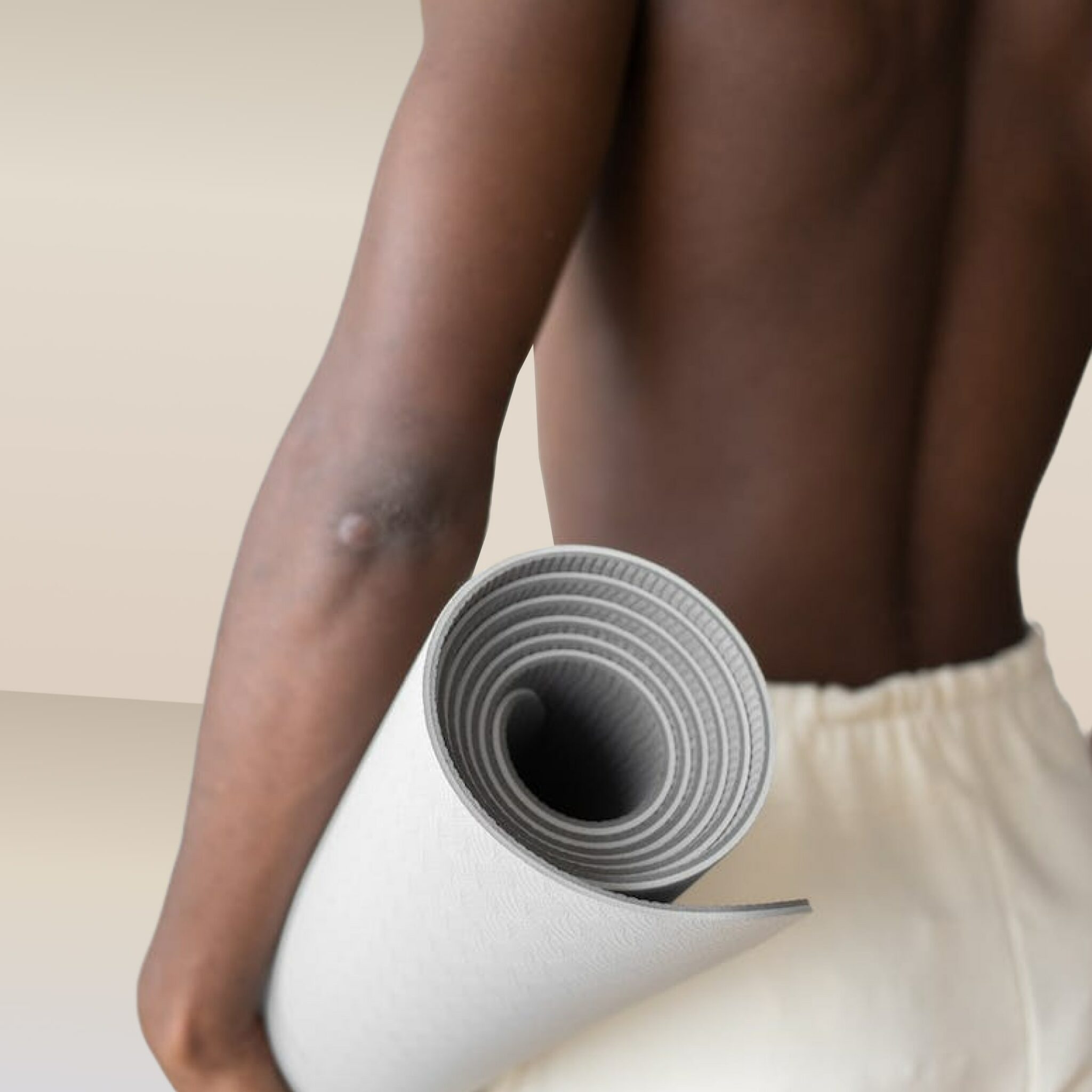When you think of Pilates, the image that often springs to mind is a serene studio filled with women practicing the popular workout. However, as more and more people discover just how deceptively tough a Pilates workout is, along with its many advantages, an increasing number of fitness enthusiasts, including men, are rising to this challenge and stepping onto the mat.
With its focus on strength, flexibility, and core stability, Pilates offers a full-body workout that can complement any fitness regimen, whether you’re a seasoned athlete or a beginner just starting out.
In this article, we’ll answer the question: “Is Pilates for Men?”, by discovering the main benefits and highlighting effective exercises men can try at home, as well as valuable tips for getting started.
Answering the question, “Is Pilates for men?”
Debunking the myth: Can men practice Pilates?
Pilates may be perceived to be female-dominated because it has gained popularity in dance and fitness studios, where women tend to be the majority. However, this doesn’t mean that everyone can’t benefit from Pilates classes.
Pilates was actually developed by professional boxer, Joseph Pilates, as a way of improving balance, strengthening muscles, and creating mental well-being for all bodies.
In fact, many professional athletes have incorporated Pilates into their training routines to improve their sport performance and prevent injuries. Famous athletes like LeBron James, Tom Brady, and Cristiano Ronaldo have all publicly endorsed the advantages of adding Pilates to their routine in their respective sports.
So, the idea that Pilates is only for women is simply a myth. Men can absolutely practice Pilates and reap the numerous advantages it offers.
The Pilates Method by Joseph Pilates
Before we tackle the many benefits of Pilates, it’s important to understand what type of exercises you’ll encounter in Pilates classes.
Known for emphasis on quality of movement rather than quantity, exercises are performed with a focus on control, proper breathing techniques, and concentration, ensuring that the certain muscle groups are targeted and engaged for enhanced performance.
Movements are typically performed on a mat, using body weight for resistance, or on specialized equipment such as the Reformer.
Physical Focus: Central to this method is the concept of the “powerhouse,” which refers to the deep core muscles, lower back, hips, and buttocks. Joseph Pilates believed that a strong powerhouse was the key to a healthy and balanced body, so expect movements that target these specific areas.
Mental Focus: It also emphasizes mental focus and breathing to create a mind-body connection. These elements can be valuable for those who want to enhance their mental clarity, reduce stress, and improve wellness in their everyday life.
The benefits of Pilates for men
While Pilates is universally beneficial, certain aspects of the practice particularly cater to men’s fitness needs and objectives, making it an excellent addition to their fitness routine. Here are some of the key advantages Pilates can provide:
1. Stability in core muscles
A primary focus of your Pilates class will be developing a strong core. The muscles, including the abdominals, back, and pelvic floor, are essential for maintaining proper posture, supporting the spine, and generating power in movements.
2. Improved functional strength in other muscle groups
While there is a focus on core work, Pilates works to build muscle strength throughout the entire body by incorporating functional movements that target multiple muscle groups often missed in other forms of exercise. This makes it a great addition for those who typically work to improve strength in their muscles through weightlifting.
3. Enhanced flexibility and range of motion
Most men tend to overlook flexibility as an aspect of fitness. However, those who engage in activities that require flexibility, such as sports or weightlifting, can particularly benefit from Pilates, as it helps with movement patterns as we age, injury prevention, spinal mobility, and reduces the risk of imbalances in muscles.
4. Better posture and alignment
Modern lifestyles, such as sitting for prolonged periods and poor posture habits, can result in muscular imbalances and postural issues. Pilates targets the muscles responsible for better alignment, such as the core, back, and shoulders.
By practicing Pilates, men can correct postural imbalances, alleviate back pain, and develop a more aligned and upright posture.
5. Injury prevention and rehabilitation
Pilates is designed to promote the development of balanced muscles, which can help in preventing injury. Additionally, Pilates movement can be used as a form of physical therapy for men recovering from injuries or surgeries.
The low-impact and customizable nature of Pilates makes it suitable for individuals with joint issues or those who need a gentle yet effective form of exercise to aid in their recovery.
6. Increased athletic performance
Pilates can significantly enhance athletic performance by improving strength throughout all muscle groups, increasing flexibility, and fostering greater control in your movement. This helps athletes generate more power, move with greater efficiency, and reduce the risk of injuries. Many athletes incorporate Pilates into their training regimens to tap into this competitive edge.
6. Stress reduction
Past the physical benefits, Pilates takes a holistic approach by emphasizing mental focus, breathing techniques, and mindfulness.
The mindful nature of Pilates allows individuals to disconnect from the outside world and focus on the present moment, promoting mental well-being and relaxation, along with general health. Engaging in Pilates can help men cultivate a stronger mind-body connection, enhance concentration, and reduce stress levels or anxiety symptoms.
Getting started: Adding Pilates exercise to your workout routine
Building a practice can be a rewarding journey that offers a host of physical and mental benefits. Here are some helpful tips to get you started and establish a strong foundation:
1. Determine your goals and objectives
Before adding Pilates to your routine, it’s essential to identify your specific goals and objectives. Are you looking to build muscle, increase spinal mobility, enhance athletic performance, or address specific areas of weakness or imbalance?
Understanding your goals will help you choose the appropriate movements and tailor your routine accordingly.
2. Find a qualified instructor
Whether you’re practicing at a Pilates studio or with your favorite online Pilates app from the comfort of your own home, being guided by a qualified and experienced instructor is crucial, especially when you are just starting.
A skilled instructor can guide you through proper technique and alignment, provide modifications when needed, and assist you in progressing safely. Look for instructors who are certified and have extensive knowledge not only of Pilates, but of human anatomy.
3. Commit to your routine
Consistency is key. Aim for regular practice, ideally two to three times per week, to see progress. As you become more comfortable, gradually increase the frequency and duration of your practice.
Additionally, challenge yourself by progressing to more advanced exercises and variations, but always honor your limits and avoid overexertion.
4. Integrate Pilates with other forms of exercise
Pilates can complement other forms of exercise in your routine. It can serve as a warm-up or cool-down activity, or you can alternate your sessions with other workouts, such as strength training, cardiovascular workouts, or sports-specific training. Finding the right balance between Pilates and other activities will help you achieve a well-rounded fitness routine.
5. Start with the fundamentals
Regardless of your fitness level or prior experience, it is crucial to start with the fundamentals and basic exercises in Pilates. These movements help you develop a strong foundation, establish proper alignment, and build core strength.
Starting with the basics also allows you to understand the principles of Pilates and develop body awareness. As you become more proficient, you can gradually progress to more challenging Pilates positions and movements.
6. Listen to Your body and progress gradually
As with any form of exercise, it’s important to listen to your body and progress at a pace that feels comfortable for you. Pay attention to how your body responds to your new routine and make adjustments if needed. Gradually increase the intensity, duration, or difficulty of the exercises as you gain strength, flexibility, and confidence.
The best Pilates exercises for men
1. Hundred
The Hundred is a classic Pilates move that targets the core muscles. It involves lying on your back, and lifting your head and shoulders off the mat into a chest curl as you engage the core, starting with the pelvic floor. You then pump the arms up and down while pressing the lower spine down to the mat to stabilize the core.
2. Plank
The Plank is an excellent exercise for strengthening multiple muscle groups. It’s performed by assuming a push-up position, with the body in a straight line, supported by the forearms and toes. Holding the Plank position engages the core muscles and promotes stability and endurance.
3. Single Leg Stretch
The Single Leg Stretch targets the abdominal muscles while also engaging the hip flexors and thighs. It involves lying on your back, lifting the head and shoulders off the mat, and alternately pulling one knee into the chest while extending the other leg straight out. This movement helps to strengthen the core, improve hip mobility, and enhance overall body control.
4. Swan
The Swan exercise focuses on strengthening the back extensor muscles, which are crucial for maintaining proper posture and spinal alignment. It involves lying on your stomach, placing your hands under your shoulders, and lifting your chest off the mat while keeping your pelvis grounded. The Swan helps to counteract the effects of sitting and promotes a strong and stable back.
5. Side Plank
The Side Plank is an effective exercise for targeting the external obliques, which are important for lateral stability and rotational movements. It’s performed by balancing on one forearm and the side of the foot while lifting the hips off the mat. This helps to build abdominal strength, improve balance, and increase overall body awareness.
6. Leg Pull Front
The Leg Pull Front is a challenging movement that targets the core, shoulders, and glutes. It involves starting in a plank position and lifting one leg off the mat while maintaining stability and control. This exercise strengthens the core, improves shoulder stability, and enhances overall body coordination.
These are just a few examples of the many Pilates exercises that are particularly beneficial for men.
Conclusion: Is Pilates good for men?
After exploring the world of Pilates for men, it’s clear that it’s is not just for women. Men can greatly benefit from incorporating Pilates into their fitness routine.
Remember that consistency and dedication are key to achieving results. By incorporating Pilates into your regular fitness routine, you can expect improved core strength, increased flexibility, strengthened muscles, better posture, and a heightened mind-body connection.
Take the leap, challenge your body and mind, and discover the transformative power of Pilates. Your journey towards a stronger, more balanced, and healthier self begins with that first session.



